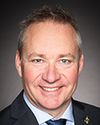Okay. That's obviously what I was hoping to hear, since I know that the provincial government in British Columbia has been working hard to improve connectivity. The types of programs put in place can have a big impact in the provinces, and as you so clearly indicated, British Columbia is among the provinces with the highest connectivity as a result of programs put in place. If I may make a partisan comment, I would point out that it was an NDP government that put those programs in place.
Now, I want to turn to the government's response and the statement from the minister after you issued your report. The Government of Canada—this is from Minister Hutchings—in a statement said the following, “The Government of Canada has made available over $7.6 billion to expand access to high-speed Internet in underserved areas”.
I'm looking at the figures from your report, and as you mentioned earlier, you've seen investments of $949 million in terms of what is actually spent. In your study of the money invested that has served to expand access to high-speed Internet, do you see $7.6 billion as a credible figure, or is it your experience that a little shy of $1 billion in actual investments has helped expand access to high-speed Internet?




